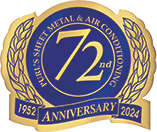Modern gas furnaces use an ignition system to start up, a more complicated but safer way than the old-fashioned use of matches. When your thermostat sends the signal to the furnace cabinet that it’s time to burn the natural gas that will generate heat, the ignition system lights up the burners.
There are a number of different ignition systems you’ll find in furnaces today. Older ones have pilot lights, while newer ones use electronic igniters such as intermittent pilot lights or hot-surface igniters. We’ll look over these three in this post.
If you need repairs on your furnace or any other heating system in Fresno, call on the company that’s helped the Central Valley stay both hot and cool since 1952: Purl’s Sheet Metal & Air Conditioning.
- Pilot lights: Also known as “standing pilot lights,” these have been in use almost as long as natural gas furnaces have existed. (In fact, the term “pilot light” goes back to colonial times and referred to a flame kept burning to restart a wood fire in a hearth.) During heating season, the pilot light burns using the fuel from the main gas line. When the thermostat signals for heat, a gas valve opens and sends gas to the burner, where the heat from the pilot light ignites the gas jets.
- Intermittent pilot lights: Because pilot lights use energy as they burn, a more efficient system was developed where the pilot light would only come on when necessary. An intermittent pilot light uses an electrical spark to turn on the pilot light when it’s necessary to ignite the burner. When the burner turns off, it also turns off the pilot until it’s needed again.
- Hot-surface igniters: These are now the most common ignition systems in furnaces, and allow for superior efficiency ratings in recent models. Hot-surface igniters do not need pilot lights at all; instead, they use a silicon nitride or silicon carbide surface that heats up as current passes through it, much like the filament of a light bulb. When the surface becomes hot enough, it ignites the burners. These electronic igniters need to be replaced every few years; usually technicians take care of this job during regular maintenance.
Speaking of maintenance… your furnace needs to have an inspection and tune-up once a year from an HVAC professional. With the Ultimate Service Agreement from Purl’s Sheet Metal & Air Conditioning, you’ll have two seasonal tune-ups each year (one for your heating, the other for your AC) as well as other benefits.
Treat your Fresno, CA heating system well: call Purl’s Sheet Metal & Air Conditioning for repairs and maintenance.

